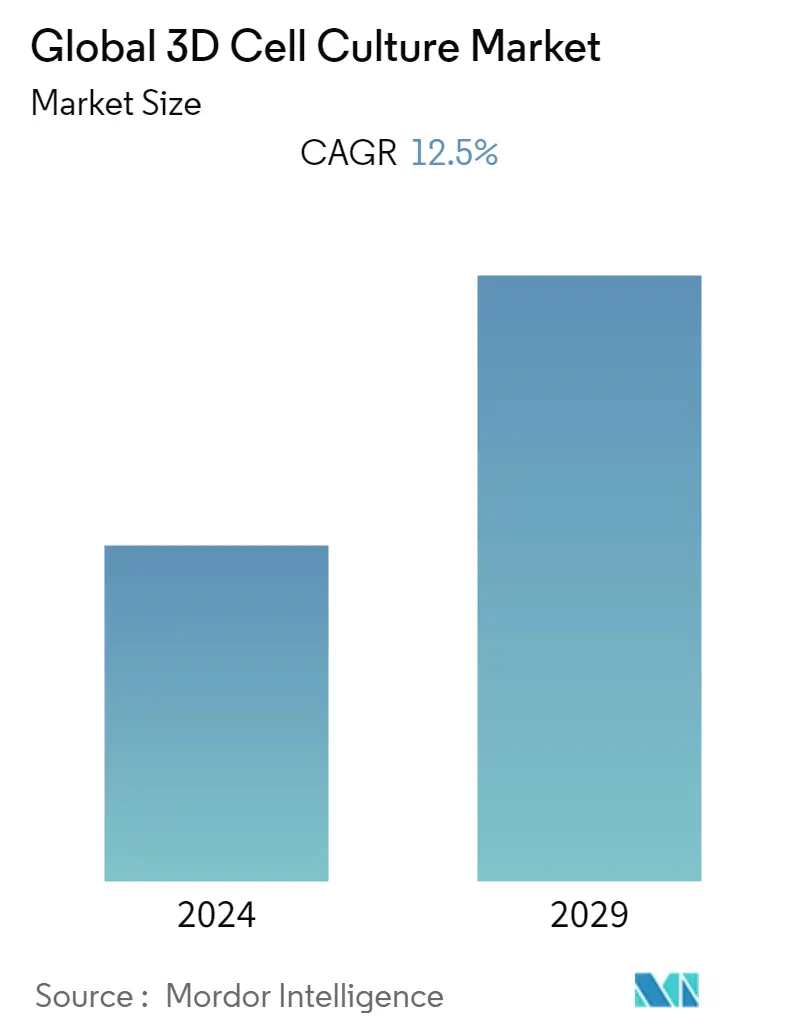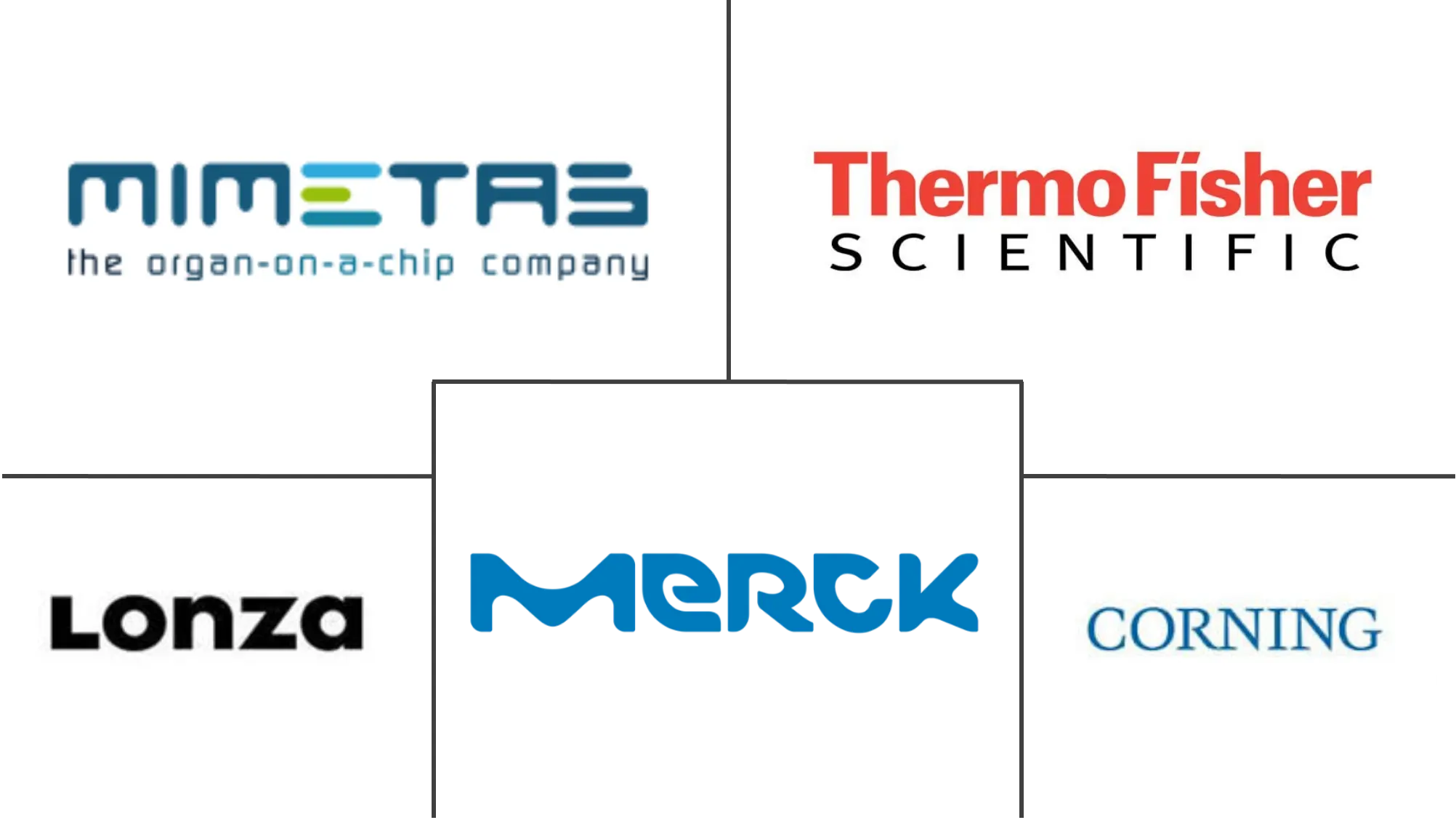Market Size of Global 3D Cell Culture Industry

| Study Period | 2019 - 2029 |
| Base Year For Estimation | 2023 |
| Forecast Data Period | 2024 - 2029 |
| CAGR | 12.50 % |
| Fastest Growing Market | Asia Pacific |
| Largest Market | North America |
Major Players
*Disclaimer: Major Players sorted in no particular order |
3D Cell Culture Market Analysis
The 3D cell culture market is expected to register a CAGR of 12.5% during the forecast period, 2022-2027.
The COVID-19 pandemic is expected to have a significant impact on the market. Researchers working on COVID-19 with relevant matrices for 3D cell culture and suitable for air-liquid interface culture need to investigate in vitro the mechanisms of the systemic consequences of cell cultures and to test potential therapies in a physiological microenvironment. This is the primary reason why 3D cell cultures are used in COVID-19 research. According to an article appearing in Frontiers Online in March 2021 titled, 3D Tissue Models as an Effective Tool for Studying Viruses and Vaccine Development, there are benefits of using 3D tissue culture techniques over 2D tissue culture when studying viral infections and the implications with regards to studying COVID-19. The study also found that techniques like organoids and spheroid cultures have been shown to replicate systems of viral infection more accurately than 2D cultures and to produce morphology and biochemical behaviors required to allow for viral infection in cases where 2D cultures do not.
The 3D cell culture market is witnessing stable growth due to factors like the use of 3D cell culture models as alternative tools for in vivo testing, the development of large-scale automated cell culture systems, and the rising need for organ transplantation. The 3D cell culture and co-culture models have huge benefits since they not only enable drug safety and efficacy assessment in a more in vivo-like context than traditional 2D cell cultures, but they can eliminate the species differences that pose limitations in the interpretation of the preclinical outcomes, by allowing drug testing directly in human systems. Additionally, with the increase in demand for organ transplantation, there is likely to be a demand for 3D cell cultures as there is a need to recapitulate complex aspects of human physiology, pathology, and drug responses in vitro. According to the organdonor.gov website of the United States Health Resources and Services Administration, in October 2021, 107,103 patients were on the national organ transplant waiting list in the year 2020. Data from the website also states that each year, 39,000 organ transplants are conducted in the United States. Thus, the increase in organ transplants is increasing the demand for research models where 3D cell cultures are used. This is expected to boost the market growth.
3D Cell Culture Industry Segmentation
3-dimensional (3D) cell culture is an artificially created environment in which biological cells are permitted to grow or interact with their surroundings in all three dimensions. This report analyzes and discusses the 3D cell culture market. The 3D Cell Culture Market is segmented by Product (Scaffold-Based 3D Cell Cultures, Scaffold-Free 3D Cell Cultures, Microchips, and 3D Bioreactors), Application (Drug Discovery, Tissue Engineering, Clinical Applications, and Other Applications), End User (Research Laboratories and Institutes, Biotechnology and Pharmaceutical Companies and Other End Users), and Geography (North America, Europe, Asia-Pacific, Middle-East and Africa, and South America). The market report also covers the estimated market sizes and trends for 17 countries across major regions globally. The report offers the value (in USD million) for the above segments.
| By Product | |||||
| |||||
| |||||
| Microchips | |||||
| 3D Bioreactors |
| By Application | |
| Drug Discovery | |
| Tissue Engineering | |
| Clinical Applications | |
| Other Applications |
| By End User | |
| Research Laboratories and Institutes | |
| Biotechnology and Pharmaceutical Companies | |
| Other End Users |
| Geography | ||||||||
| ||||||||
| ||||||||
| ||||||||
| ||||||||
|
Global 3D Cell Culture Market Size Summary
The 3D cell culture market is experiencing robust growth, driven by its application as an alternative to traditional 2D cultures and animal models in drug development and research. This market is gaining traction due to the ability of 3D cell cultures to mimic human physiology more accurately, which is crucial for drug safety and efficacy assessments. The COVID-19 pandemic has further accelerated the adoption of 3D cell cultures, as they offer a more relevant model for studying viral infections and testing potential therapies in a physiological microenvironment. The demand for organ transplantation is also contributing to market expansion, as 3D cell cultures are essential for recapitulating complex human physiological and pathological responses in vitro. The integration of microchip technologies with 3D cell cultures is enhancing real-time analysis capabilities, thereby boosting the market's growth prospects.
North America, particularly the United States, dominates the 3D cell culture market, supported by significant investments in research and development and technological advancements in the region. The presence of major players such as Corning Incorporated, Lonza AG, Merck KGaA, and Thermo Fisher Scientific intensifies the competitive landscape. These companies are actively expanding their portfolios and developing innovative solutions to meet the growing demand for 3D cell culture technologies. The market is characterized by continuous advancements and the introduction of new products, such as Amerigo Scientific's expanded cell culture portfolio and Jellagen Limited's JellaGel Hydrogel, which cater to various research applications. As the need for more accurate and efficient research models continues to rise, the 3D cell culture market is poised for sustained growth.
Global 3D Cell Culture Market Size - Table of Contents
-
1. MARKET DYNAMICS
-
1.1 Market Overview
-
1.2 Market Drivers
-
1.2.1 Use of 3D Cell Culture Models as Alternative Tools for In Vivo Testing
-
1.2.2 Development of Automated Large-scale Cell Culture Systems
-
1.2.3 Rising Need for Organ Transplantation
-
-
1.3 Market Restraints
-
1.3.1 Lack of Experienced and Skilled Professionals
-
1.3.2 Budget Restriction for Small- and Medium-sized Laboratories
-
-
1.4 Porter's Five Forces Analysis
-
1.4.1 Threat of New Entrants
-
1.4.2 Bargaining Power of Buyers/Consumers
-
1.4.3 Bargaining Power of Suppliers
-
1.4.4 Threat of Substitute Products
-
1.4.5 Intensity of Competitive Rivalry
-
-
-
2. MARKET SEGMENTATION (Market Size by Value - USD million)
-
2.1 By Product
-
2.1.1 Scaffold-based 3D Cell Cultures
-
2.1.1.1 Micropatterned Surface Microplates
-
2.1.1.2 Hydrogels
-
2.1.1.3 Other Products
-
-
2.1.2 Scaffold-free 3D Cell Cultures
-
2.1.2.1 Hanging drop microplates
-
2.1.2.2 Microfluidic 3D cell culture
-
2.1.2.3 Other Products
-
-
2.1.3 Microchips
-
2.1.4 3D Bioreactors
-
-
2.2 By Application
-
2.2.1 Drug Discovery
-
2.2.2 Tissue Engineering
-
2.2.3 Clinical Applications
-
2.2.4 Other Applications
-
-
2.3 By End User
-
2.3.1 Research Laboratories and Institutes
-
2.3.2 Biotechnology and Pharmaceutical Companies
-
2.3.3 Other End Users
-
-
2.4 Geography
-
2.4.1 North America
-
2.4.1.1 United States
-
2.4.1.2 Canada
-
2.4.1.3 Mexico
-
-
2.4.2 Europe
-
2.4.2.1 Germany
-
2.4.2.2 United Kingdom
-
2.4.2.3 France
-
2.4.2.4 Italy
-
2.4.2.5 Spain
-
2.4.2.6 Rest of Europe
-
-
2.4.3 Asia-Pacific
-
2.4.3.1 China
-
2.4.3.2 Japan
-
2.4.3.3 India
-
2.4.3.4 Australia
-
2.4.3.5 South Korea
-
2.4.3.6 Rest of Asia-Pacific
-
-
2.4.4 Middle-East and Africa
-
2.4.4.1 GCC
-
2.4.4.2 South Africa
-
2.4.4.3 Rest of Middle-East and Africa
-
-
2.4.5 South America
-
2.4.5.1 Brazil
-
2.4.5.2 Argentina
-
2.4.5.3 Rest of South America
-
-
-
Global 3D Cell Culture Market Size FAQs
What is the current Global 3D Cell Culture Market size?
The Global 3D Cell Culture Market is projected to register a CAGR of 12.5% during the forecast period (2024-2029)
Who are the key players in Global 3D Cell Culture Market?
Corning Incorporated, Lonza AG, Thermo Fisher Scientific, Merck KGaA and MIMETAS BV are the major companies operating in the Global 3D Cell Culture Market.

